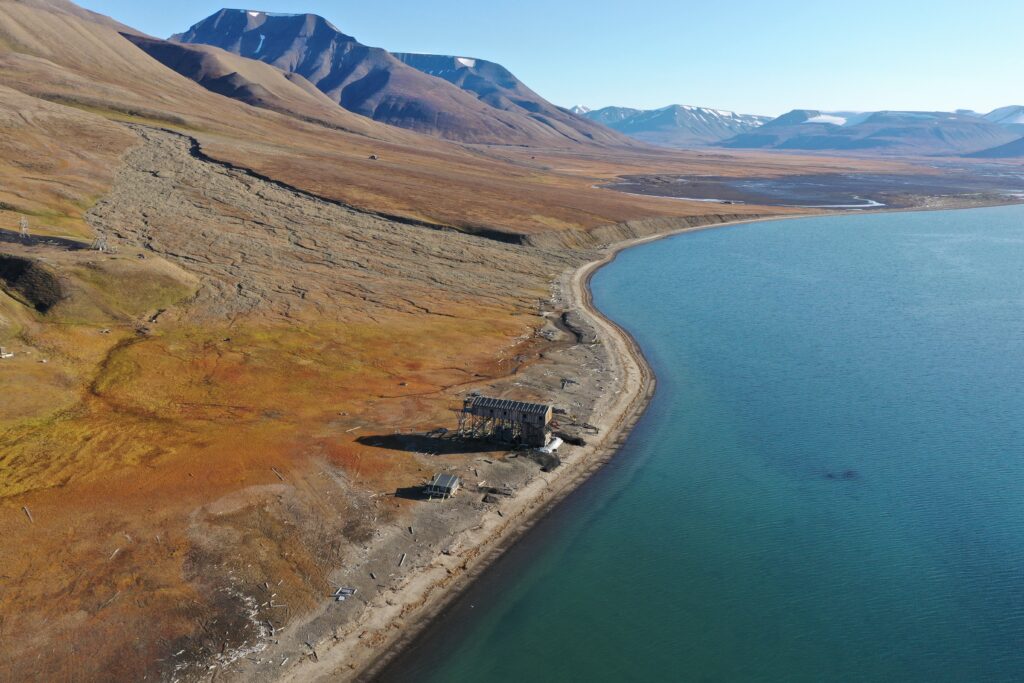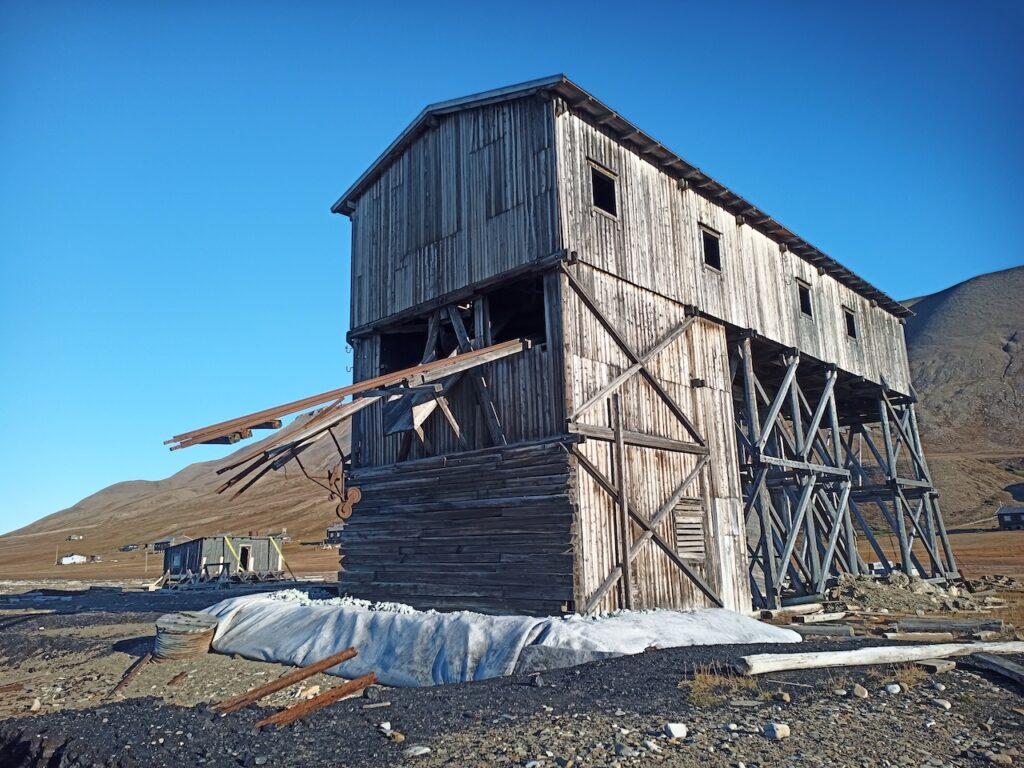As part of our ongoing series on climate and heritage, we spoke with Paloma Guzman, researcher at the Norwegian Institute for Cultural Heritage Research (NIKU), about her extensive work on climate adaptation in heritage policies. From her architectural background to her role in the THETIDA project, Guzman shares insights into the evolving intersection of heritage, sustainability, and policy.

Paloma Guzman in front of the Gol Stave Church at the Norwegian Museum of Cultural History in Oslo
Could you introduce yourself and tell us in what way you are involved in the topic of climate change and heritage?
My name is Paloma Guzmán, and I am a researcher at the Norwegian Institute for Cultural Heritage Research. I began my academic career studying the integration of heritage and urban development fields, initially focusing on the Sustainable Development Goals framework. Over time, my work shifted towards climate adaptation policies, and I have been involved in research projects and developing guidance tools on climate adaptation and climate risk strategies for the cultural heritage sector.
My perspective has been shaped by analyzing global policy trends and their adoption within the cultural sector, including international initiatives that integrate technical monitoring approaches with policy and management strategies.
One of my current projects is THETIDA, funded by the EU’s Horizon program for cultural heritage. Its aim is to protect European coastal and water-related cultural heritage from climate-related and environmental hazards, including climate change, pollution, and water-based risks. The project develops monitoring and analytical tools to support the management and prevention of damage, working with seven pilot sites across Europe, including locations in Norway and the Netherlands (Lake Ijssel).
In what way do you already experience the impact of climate change on heritage (in your work)?
Our Norwegian pilot site is an industrial mining settlement with a cableway station mainly built from wood and metal, in front of Longyearbyen. This remote location faces severe threats from coastal erosion and permafrost thaw, which cause soil subsidence, slope instability, and timber rot. While the government has implemented measures to stabilize structures and prevent collapse, maintaining such a remote site will be costly.
Since the site is no longer in active use, there is an ongoing debate about its future. On one hand it is among the prioritized sites in Svalbard; on the other hand, the complexity of viable interventions, limited resources and competing priorities make its preservation difficult to justify. Without further action, the site is likely to disappear within the next 10 to 20 years—possibly sooner if patterns of extreme weather accelerate the damage.
Deciding which sites to preserve is a complex process, especially when interventions are costly and resources are limited. In many cases, it may be more justifiable to prioritize safeguard heritage that is actively used and holds daily relevance for communities. Other, more remote sites may ultimately be lost due to material degradation and climate impacts, often without being noticed. To make such difficult choices legitimate, the sector requires systematic monitoring, thorough documentation, and transparent decision-making to support priorities that are set in a fair and accountable way.

Drone image of the Hiorthhamn cable station on the east side of Adventfjorden, Svalbard (Norway)
What should be done to limit the possible damage of climate change on heritage?
Adaptation does not always require large-scale engineering; it often begins with supporting owners and managers in basic preventive conservation. Climate change is altering environmental patterns, making traditional maintenance approaches insufficient. It also challenges some long-standing conservation principles. Questions of what counts as authentic, or when to limit interventions, need to be revisited to strike a balance that allows communities to keep using and valuing their heritage even as conditions change. For example, wooden structures in flood-prone areas may now need different treatments, protective coatings, or minor design adjustments to remain viable and resilient.
Monitoring—both scientific and community-led—plays a key role in this process. It allows us to pay attention to different types of change, from slow material decay to sudden weather impacts, and to perceive where human action needs to adapt. In THETIDA, we explore citizen science as a way to complement environmental data: residents and local stakeholders help collect data and track changes over time by using low-tech, inclusive methods to monitor vulnerable sites. This approach provides valuable, site-specific insights and builds a sense of shared responsibility for both environmental and heritage conservation.
Adaptation also requires flexibility in conservation thinking. In some cases, preserving the “spirit” and knowledge of a site may be more sustainable than striving to retain every physical element, especially when total loss cannot be avoided.
Finally, adaptation strategies must be embedded within broader climate resilience policies. Heritage is closely interconnected with housing, tourism, infrastructure, environmental management, and other sectors, depending on the local context. Coordinated action across these areas helps ensure that measures to protect heritage also strengthen community resilience as a whole—making them more sustainable in the long run.

Do you see a role for heritage in climate adaptation or climate mitigation?
Absolutely. Cultural heritage is not just a passive victim of climate change—it can actively contribute to solutions. Cultural narratives, traditions, and place-based knowledge should be used as a reference to localize sustainable practices, guide decision-making, and strengthen social cohesion in times of change. By rooting climate goals in local realities, heritage makes adaptation strategies meaningful and thus, easier to adopt. Historic structures also illustrate this point: they were built for a reason, often in direct relation to the ecology of a place and the ways humans interacted with it at a given time. Their continued presence—and the challenges they now face—tell us how our relationship with the landscape has shifted, and how it must adapt again under climate change. Many historic buildings embody climate-responsive features, such as natural ventilation, passive cooling, and the use of local materials, which can inform contemporary sustainable architecture.
But heritage should not be reduced to a technical checklist of solutions. The very intention to conserve historic environments, for example, invites us to reflect on the patterns we choose to build our life systems—the values we prioritize, the resources we consume, and the ways we balance continuity with change. This is how I personally see it, and why I value working with heritage: it is not only about deciding what to do, but about creating space to reflect. It reminds us to keep an open mind, since there is no single solution that fits all—just as the diversity of heritage shows the many ways human creativity has connected with place across time.
However, these opportunities require careful management. When poorly handled, tourism and heritage drive to unsustainable consumption patterns, put pressure on local resources, and increase emissions if left unchecked. Heritage professionals must therefore build stronger collaborations across sectors to integrate heritage into broader sustainability strategies. In doing so, heritage supports both cultural continuity and the long-term ecological health of the communities it serves. For me, this continuity—aligned with ecology and environment—adds a deeper human meaning to heritage, showing that adaptation is part of how we create, connect, and find our place in the world.
What are your expectations for the impact of climate change on our European heritage in the future?
I hope the heritage sector will move beyond reactive, crisis-driven responses and towards proactive, collaborative planning. This means making climate adaptation and risk management central to heritage policies, rather than treating them as add-ons. It also means accepting that not all heritage can or should be preserved.
Some sites will inevitably be lost to climate change, environmental degradation, or material decay, while others can be safeguarded with targeted measures. The key is to develop transparent, inclusive processes where communities, scientists, and policymakers work together to set priorities.
In THETIDA, we are testing how continuous monitoring, digital documentation, and cross-sector cooperation can guide these decisions. Our goal is to leave future generations not only with preserved heritage, but also with a record of its cultural meaning and lessons for resilience and adaptation.
Is there anything else you would like to add?
In our next participatory exercise within THETIDA, we are gathering local and national authorities to share interim results and provide feedback. We also want to open some of the difficult questions: the relevance of policies built in the 1970s, which were designed for different goals than the ones we face today; the Arctic’s unique characteristics and the possibility of irreversible losses; and the role of adaptation policy frameworks in addressing loss and damage. At the same time, we see digital tools as a key enabler—helping to bridge monitoring, participatory approaches, and documentation, and making climate risk management for heritage more inclusive and scalable.
Through this dialogue, we aim to build momentum for practical, scalable solutions that can benefit not only our pilot sites, but also other vulnerable heritage sites across Europe. Climate change forces us to rethink the very purpose of heritage conservation: it is no longer solely about preserving the past, but about ensuring heritage remains meaningful and relevant in a rapidly changing world.
More information about THETIDA and the different pilot sites: THETIDA.eu
